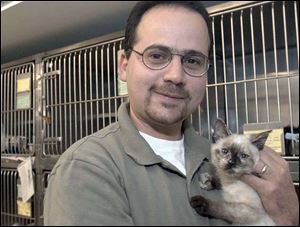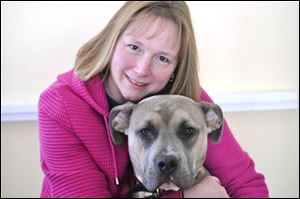
Shelters' killing of dogs will end, experts assert
Commitment to saving animals called key at D.C. talks
8/1/2011

WASHINGTON -- For Nathan Winograd, ending the large-scale killing of dogs and cats in our nation's animal shelters is not a matter of "if" but "when."
An author and executive director of the national No Kill Advocacy Center, Mr. Winograd has heard all the reasons offered by municipal dog pounds and private shelters about why that's impossible: lack of space, not enough money, too many animals that nobody wants. But he doesn't buy any of them.
Not because Mr. Winograd is a dreamer or an "extreme" animal-rights activist. It's because he's proved that saving 90 percent or more of shelter animals can be done.
As former leader of the Tompkins County SPCA in upstate New York in 2001, Mr. Winograd turned a typical struggling shelter into the first "no kill" haven in the United States, drastically reducing kill rates to 7 percent. Today, dozens of shelters across the country have replicated his success, implementing the same kinds of policies and procedures as Tompkins County.
"This is a battle that we are winning, and we will win," Mr. Winograd told a crowd of 400 animal advocates and shelter and rescue workers this weekend during the third annual No Kill Conference in Washington. "No more excuses, no more compromises, no more killing."
The conference included talks by directors of the nation's top-performing animal shelters, animal behaviorists, and prominent animal rights lawyers. They shared their experiences and advice on how to save dramatically more stray and abandoned animals from death.
Repeatedly the speakers criticized common practices and beliefs that lead to the killing of millions of healthy dogs and cats at animal shelters each year.
While even "no kill" shelters usually euthanize some animals, their mission is to find homes for every healthy and treatable animal in their care. That should amount to more than 90 percent of a shelters' population, the conference speakers maintained. The figure is a far cry from the majority of animal shelters and control operations in the country, where it's not uncommon for half or more of all creatures entering the facilities to be killed.
In Lucas County, the dog pound destroys approximately 43 percent of animals, Dog Warden Julie Lyle has said.
The secret to creating a "no kill" shelter and community, Mr. Winograd said, is in introducing a comprehensive set of programs and services, something he terms the "no kill equation." These include offering high-volume, low-cost spay and neuter services; transferring animals to other rescue groups to free up space; allowing volunteers to foster animals; running a vibrant and well-publicized adoption program that includes taking animals to events off-site; finding ways to help pet owners keep their animals; offering medical and behavioral care; running an effective volunteer program, and increasing community involvement in the shelter.
Most of all, Mr. Winograd and other conference speakers said, saving more animals requires a desire to do so.
Commitment crucial

Nathan J. Winograd of the No Kill Advocacy Center addressed animal advocates and shelter workers.
"The one thing you have to have is simply the commitment," said Mike Fry, executive director of Animal Ark, a "no kill" shelter serving the Minneapolis/St. Paul area in Minnesota. "What it looks like after that is hard to predict; but once you've got that, you've got what you need."
Among the shelter directors who have found that desire is Bonney Brown, executive director of the Nevada Humane Society in Reno. In under five years, she boosted her organization's animal save rate from 65 percent to about 94 percent. Her success arose largely from the creation of dynamic marketing strategies, which include funny online videos, special adoption events, pet festivals, setting adoption goals and promoting them through the media and in the community, and having volunteers walk dogs wearing special "adopt me" vests.
She has also made the shelter more welcoming and allows community members to come in and play with the animals whenever they want.
Ms. Brown's efforts have not only increased pet adoptions but, because of the shelter's publicized success, have drawn in greater community support and donations, she said. This despite Reno's standing as an area with one of the nation's highest unemployment rates, with widespread social and economic problems, she added.
"When people see our statistics they assume we must live in some idyllic place. That's not the case," Ms. Brown said. "What makes the difference is deciding you're going to save [the animals]. It's making that absolute decision."
Ms. Brown's efforts are aided by the Reno area's animal-services director, Mitch Schneider, with whom the organization shares a building. Mr. Schneider changed how his department deals with dogs that are found running loose in the street.
Seeking out owners
Instead of locking the dogs away, waiting for owners to come for them, and charging a fee, animal-control officers actively seek out the owners and deliver the dogs back. First-time offenders do not pay a fine, he said. The result is dramatically fewer dogs at the county shelter, and a steep drop in kill rates, he maintained. It also saves the county money in kenneling and kill-related costs, he said.
"Our success really boils down to embracing change, embracing technology, and thinking outside the box," Mr. Schneider said. "Holding and ransoming [dogs] is not the way to do business."
The use of temperament tests to decide whether dogs are put up for adoption or put to death came under almost universal condemnation by conference speakers, particularly the animal behaviorists and "no kill" shelter directors.
Aimee Sadler, the behavior and training program director for the Longmont Humane Society in Colorado, said the tests do not accurately predict a dog's behavior and results should not be used to determine whether an animal is killed. Instead, they should be used to help decide which dogs require more time with volunteer trainers, she said.
Most dogs can overcome behavioral issues with training, socialization, and exercise, Ms. Sadler maintained. She said most dogs that act aggressively do so out of fear, a not-uncommon reaction to a stressful shelter environment. Only a tiny percentage -- as few as 2 percent -- are actually vicious and dangerous to humans, and those dogs do need to be put down, she added.
Behavior training does not have to be expensive, Ms. Sadler and other speakers said. Most shelters rely on volunteers to implement such efforts, which are as simple as providing dogs with regular "play-group" time where they socialize and run around with other dogs outside.
'Pit bull' efforts

Stacey Coleman is executive director of Animal Farm Foundation, a rescue organization that specializes in ‘pit bulls.’ She says there is no way to predict a dog’s behavior based on breed.
A number of speakers focused on problems facing "pit bull"-type dogs, which tend to spend longer periods at shelters and frequently end up being destroyed because shelters cannot find people to adopt them or because the dogs are deemed inherently vicious.
Stacey Coleman, executive director of Animal Farm Foundation, a rescue organization specializing in "pit bulls," said there is no common agreement as to what a "pit bull" actually is, and studies show dogs are miscategorized as "pit bulls" as much as 75 percent of the time. There is also no way of determining how a dog will behave based on its breed, she said.
Instead, Ms. Coleman said, categorizing dogs as "pit bulls" has become an excuse to destroy them.
"Dogs can only have dog traits," Ms. Coleman stated. "There is no one single behavior that is unique to one type of dog."
Myths, fears
Ms. Coleman said her shelter employs a variety of tactics to help get more "pit bulls" adopted and dispel the myths and fears surrounding them. These include not imposing additional requirements on adopters interested in taking home a "pit bull," using marketing strategies that emphasize the dogs' potential and good qualities, teaching the "pit bulls" easy tricks that make them stand out to adopters, integrating "pit bulls" into adoption events with other types of dogs, providing lists of "pit bull" friendly area housing and home insurers to adopters, and holding "Community Pet Days" that promote responsible "pit bull" and pet ownership in low income, urban areas where the dogs are traditionally seen to be a problem.
Despite the stereotypes surrounding such communities as havens for dog-fighting, Ms. Coleman said most "pit bull" owners in these areas simply require more education and resources to help them adequately take care of their dogs.
"Overwhelmingly, most people want to take care of their pets," Ms. Coleman said. "Go out and empower the people that own the dogs."
Contact Claudia Boyd-Barrett at: cbarrett@theblade.com or 419-724-6272.